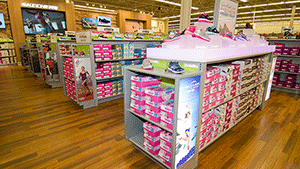
Last week’s opening of the first Skechers concept store within Meijer’s Knapp’s Corner store in Grand Rapids, Mich., is the latest in a number of recent tie-ups between supermarket operators and nonfood retailers.
In the U.K., a number of the leading retailers have been looking to these kinds of arrangements to both drive traffic to their stores and to make better use of under-utilized space.
Sainsbury’s, one of the U.K.’s leading supermarket operators, has identified excess space in up to a quarter of its stores. It has recently announced a partnership with Argos, a leading catalogue retailer. This tie-up will see 10 digital stores open within Sainsbury’s supermarkets as part of an initial test that will enable grocery store shoppers to buy Argos’ entire range of nonfood products.
At Asda-Walmart, which is often the test-bed for innovation that is later replicated in other markets, the retailer has recently announced a partnership with Decathlon, a leading France-based sports store operator, to test a new in-store concept.
At Tesco, foodservice has been the focus, with the retailer making acquisitions to enhance the in-store dining experience. One of the most notable was the Giraffe chain of family-friendly, casual dining restaurants, which the retailer has now introduced into a number of its stores. The aim here is to encourage shoppers to spend longer in store, and enhance the overall destination status of the stores.
And this is a trend we can expect to see accelerate. Changes in the retail landscape, driven primarily by ecommerce, are making in-store space less premium than it once was. We continue to see the migration of grocers’ nonfood sales to online, while new options for grocery ecommerce are emerging.
Many of the solutions being developed in the more advanced grocery ecommerce markets in Europe and Asia are focused on the pick-up of online orders away from physical stores. Transit locations, such as train and bus stations, universities, workplaces and gas stations are all being tested.
So, what is the outlook here in the U.S., where the hypermarket concept was invented and which has become the mainstay of many retailers’ operations? On the foodservice front, U.S. grocers are ahead of most of their international counterparts. Retailers such as Whole Foods Market, Weis Markets and Wegmans have been at the forefront of introducing innovative food solutions and creating that elusive destination status for their stores.
There are, however, big opportunities for new partnerships with nonfood retailers to bring in a broader mix of products. As we have seen in the U.K. market, this does not have to mean full-size stores, but smaller kiosks offering a selection of the most popular items along with interactive screens offering ordering and pick-up options.
What concepts have you seen being tested beyond coffee shops and banking? How do you think retailers could make better use of their space to drive traffic going forward?





